You’re likely no stranger to the demands of a physically demanding job, where one misstep can lead to serious injury. That’s why choosing the right safety boots is crucial. Men’s steel toe safety boots offer a reliable solution, with their rugged protection and versatile designs catering to various occupations. From manufacturing to logging and welding, these boots are built to withstand harsh environments. But with so many options available, how do you select the best boots for your specific job requirements? It’s essential to consider the features and certifications that matter most to your profession.
Choosing the Right Safety Boots
When it’s time to gear up for a job that requires your safety boots to be more than just footwear, you need to choose the right ones. You’ll want boots that meet your industry’s specific safety standards, so start by checking the certifications required for your job.
Look for boots that meet or exceed standards set by organizations like the American Society for Testing and Materials (ASTM) or the Occupational Safety and Health Administration (OSHA).
Next, consider the hazards you’ll face on the job. Will you be working with heavy objects, in extreme temperatures, or on uneven terrain?
Choose boots with features that address these hazards, such as slip-resistant soles, insulation, or ankle support. Don’t forget to think about your personal comfort and preferences, too.
You’ll be wearing these boots for long periods, so choose a pair that fits well and feels comfortable. By considering these factors, you’ll be able to select the right safety boots for your job and stay protected on the job site.
Types of Steel Toe Boots
Having chosen the right safety boots for your job, it’s time to explore the various types of steel toe boots available. You’ll find that different types of steel toe boots cater to specific industries and job requirements.
For instance, logger boots are ideal for those working in the forestry or logging industry, with their rugged outsoles and high ankle support. Hiker boots, on the other hand, are perfect for those working in construction or outdoor settings, providing excellent ankle stability and traction.
Insulated boots are designed for workers in cold environments, keeping your feet warm and dry. Composite boots, made from a combination of materials, offer lightweight protection without compromising on safety. EH-rated boots are designed for workers in electrical environments, providing protection from electrical hazards. And, finally, metatarsal boots offer additional protection for the metatarsal bones in your feet.
Each type of steel toe boot is designed to meet the unique demands of a specific job or industry, so it’s essential to choose the right type for your work environment. By selecting the correct type, you’ll be able to perform your job safely and efficiently.
Features to Look for Safety
Several key features can make a significant difference in the safety and effectiveness of your steel toe boots. When shopping for a pair, you should look for boots with a sturdy sole that provides slip-resistance. This is especially crucial if you work in environments with wet or oily surfaces.
A good grip can prevent slips, trips, and falls, reducing the risk of injury.
You’ll also want to consider the boot’s electrical hazard rating. If you work with electrical equipment, look for boots with an EH rating to protect you from electrical shock.
Additionally, check the boot’s insulation and breathability. A breathable membrane, such as Gore-Tex or eVent, can keep your feet dry and comfortable in cold or wet conditions.
The boot’s upper material is also important. Leather or synthetic materials can provide durability and protection from abrasions.
A padded collar and tongue can also enhance comfort and prevent blisters.
Finally, consider the boot’s certification. Look for boots that meet or exceed ASTM standards for safety and performance.
Best Boots for Specific Jobs
You don’t have to be a construction worker to need steel toe boots, as various professions require a solid pair of boots to get the job done. If you’re in the manufacturing industry, look for boots with electrical hazard (EH) protection and slip-resistant outsoles to handle varied factory floor conditions.
For those working in oil rigs or chemical plants, boots with chemical-resistant materials and a metatarsal guard provide added protection against hazardous substances and falling objects.
In the logging or forestry industry, boots with crampons or lug soles offer better traction on uneven terrain. If you’re a welder, boots with a heat-resistant sole and a metatarsal guard protect your feet from molten metal and sparks.
For those working in cold environments, insulated boots with a waterproof membrane keep your feet warm and dry. Ultimately, the right pair of boots can make a significant difference in your safety and job performance. By choosing boots tailored to your specific job requirements, you can minimize risks and stay focused on the task at hand.
Safety Standards and Certifications
When choosing the right pair of steel toe boots for your specific job requirements, it’s also vital to consider the safety standards and certifications they meet.
You’ll want to look for boots that meet or exceed standards set by reputable organizations such as the Occupational Safety and Health Administration (OSHA) and the American Society for Testing and Materials (ASTM).
The ASTM has a specific standard for safety footwear, known as ASTM F2413-18. This standard requires that boots meet certain criteria for impact and compression resistance, as well as electrical hazard protection.
You should also check for the “EH” rating, which indicates that the boots meet the ASTM standard for electrical hazard protection.
Additionally, you may see certifications such as the CSA (Canadian Standards Association) certification or the EN (European Standard) certification.
These certifications indicate that the boots meet specific safety standards for impact, compression, and other hazards. By choosing boots that meet these safety standards and certifications, you can ensure that your feet are protected from workplace hazards.
Conclusion
You’ve learned about the different types of men’s steel toe safety boots and their features. You’ve also discovered how to choose the right boots for your specific job and the importance of meeting safety standards and certifications. Now, it’s time to prioritize your steel toe cap boots mens and find the perfect boots that offer rugged protection, comfort, and compliance. Remember, the right boots can make all the difference in your workday.


